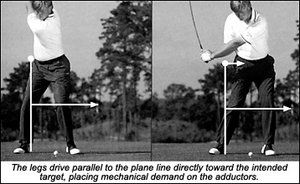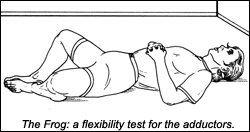Spearheaded by burgeoning scientific and clinical research literature, psychedelics have reached a level of media coverage and popular interest that has not been seen for over half a century. By “psychedelics,” we are referring to the unique class of substances that includes psilocybin (the active compound found in so-called “magic mushrooms”), LSD, dimethyltryptamine (DMT), ayahuasca, 5-MeO-DMT, and mescaline – each of which occurs in the natural world (except for LSD, which is a semi-synthetic compound).
Chiropractic and Golf
In my previous article in this series, "Leg Drive - The Backswing," I left you at the "set-point": the momentary pause at the top of the backswing, just before you release all that stored kinetic energy toward the target during your downswing.
To review, there are four key points regarding the backswing. (Remember, the "plane line" extends from the ball to 10 feet behind the ball.)

The Adductors
The lateral drive of the legs and pelvis, from the set-point at the top of the backswing to just before impact with the ball, is about 6-8 inches. Proper leg drive puts a tremendous demand on the adductors. At the start of the downswing, there will be a brief lateral slide of the pelvis as the legs drive toward the target. When properly executed, the adductors stretch in response to this mechanical demand. If they are too tight, muscular strain is inevitable. Eventually, your patients will swing around their hips to avoid adductor strain. Swinging around tight adductors results in loss of power, and contributes to an inconsistent golf swing.
Clinical Examination
One way to test the flexibility of the adductors is to have your patient touch the soles of his or her feet while in the supine position, with the knees bent. Within 20-30 seconds, the knees should release to about 12-18 inches from the floor with no adductor discomfort. Observe if one knee comes to rest higher than the other. This abnormal finding indicates chronic unilateral myofascial shortening or subluxation of the pelvic girdle.


If there is subluxation of the pelvis girdle, adjust accordingly. If there is poor adductor flexibility, have your patient rest in the frog position daily for 60 seconds until the adductors release.
Jeffry Blanchard, DC
Encinitas, California
jeff@doctorforgolf.com
DoctorForGolf.com



